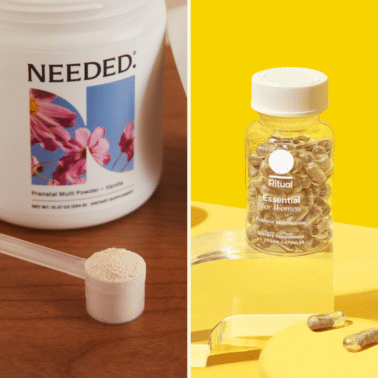With the hopes that this helps you feel like a more informed and confident consumer, here are the top 5 personal care ingredients I personally choose to avoid and WHY! If you want to avoid the drugstore label reading exercise altogether, I’ve also included links to a few companies that I trust completely towards the end of this article.
Have you ever walked into the personal care isle at the convenience store (think soap, toothpaste, deodorant, shampoo, etc.) and thought to yourself, “which of these are the safest for me to use?” It’s a simple question with a not-so-simple answer. The “is this safe?” waters are murky, especially when you’re standing in front of a sea of products with inconsistent ingredient labeling and pretty packaging. Which do you rely on? Do you trust the packaging or do you take a deep breath and try to make sense of the inconsistently labeled ingredients? It’s a tough call and to be honest, I used to give up before I found any answers. With fresh cuts of meat sitting in my shopping cart and packages of butter getting soft, I just couldn’t talk myself into taking the time to dedicate myself to reading labels in the personal care isle. SO, I’d just go back to old faithful! I’d judge a book by its cover (hm, this toothpaste looks like more natural packaging, I’ll get this one!) OR just fall back on what I know works (Dove deodorant hasn’t failed me in over 10 years). Sound familiar?
I spend a lot of time and energy making sure that I’m fueling my body with healthy, wholesome, healing foods. I make sure I drink plenty of clean water, get quality sleep, and care for my body with a mixed fitness program. I avoid pesticides, choose organic where possible, put an importance on sourcing grass-fed/pastured proteins, and hold my breath when I walk past a neighbor’s yard who just dusted with ant killer. I do all of this, but I wasn’t paying much mind to what I was putting ON my body. It was a disconnect – and one I’ve worked to right size (with baby steps) for years.
The point of today’s post is to help provide you with a quick cheat sheet of the 5 ingredients that I recommend avoiding in personal care products.
Yes – there are MORE than 5 ingredients I choose to avoid, but sometimes more information is daunting, not helpful. So I’m narrowing it down to 5 so we can have a little more confidence when we walk into that personal care isle. Hopefully, you’ll be able to quickly scan labels for the following terms and feel like a more powerful, informed consumer.
5 Personal Care Ingredients To Avoid (and why)
1. Triclosan
A synthetic antimicrobial (antibacterial) chemical that is used in most antibacterial soaps, toothpastes, and antiperspirants. It is proficient at killing both good and bad bacteria. Some studies report that the use of triclosan-containing cleansers can actually support the growth of antibiotic-resistant bacteria (scary mutant bugs). Triclosan is also a suspected endocrine (hormone) disruptor that is known to accumulate in body fat, resulting in a myriad of potential terrifying conditions to include decreased fertility, liver damage, and nervous system complications.
2. Phthalates
A large group of chemicals used in a multitude of products to help make fragrances stick to skin and products more flexible. Actually banned from personal care products in the European Union, you can usually find them in nail polish, perfumes, deodorants, lotions, and hair spray. They’re highly suspected endocrine (hormone) disruptors with some reports of fetal birth defects. They can be absorbed orally (think of the dizzying fumes in a beauty salon) and through the skin. It’s important to note that phthalates are not always labeled – this is because they’re likely considered by the producing company as an ingredient in their signature fragrance, whose lists are protected as “trade secret.”
3. Polyethylene Glycol, Propylene Glycol, and Other PEG Compounds
A petroleum-based thickener, solvent, and softener used in creams, shampoos, makeup, and sunscreens to help carry moisture and provide that luscious cream base we know and love. PEG compounds are skin irritants – making skin even more penetrable, allowing for other not-ideal ingredients easier passage into our bloodstream. Products with this listed on the ingredient list (or not listed) are highly likely to contain other carcinogenic compounds such as ethylene oxide, a known carcinogen (cancer-causing agent).
4. Parabens
A preservative typically used to extend the shelf life of products by preventing the growth of bacteria and mold. They’re highly suspected male and female endocrine (hormone) disruptors that are absorbed by the skin, with some reports of them showing up on biopsies from breast tumors. They’re believed to have properties that mimic our own estrogen and can confuse the body by adhering to our estrogen receptors. They’re found in shampoos, face cleansers, body wash, body lotion, and many foundations. Of the ingredients on this list, parabens are probably one of the most known, which is why you’ll likely see products specifically labeled as “paraben-free.”
5. Sodium Lauryl Sulfate and Sodium Laureth Sulfate (SLS and SLES)
These are detergents and surfactants that are found in an incredible number of personal care products on our (USA) isles. They help make products foam and bubble (think face wash, bubble bath, shampoo, dish soap, + even car wash) and are known irritants causing damage to the skin and eyes. Like PEG compounds, they’re likely contaminated with ethylene oxide (cancer-causing) and may also react with other common associated chemicals to produce nitrosamines, which are more lovely carcinogens. SLS & SLES can even have an impact on your skin’s ability to retain moisture naturally – meaning, you’ll become more dependent on store-bought moisturizers, causing a nasty, chemical-laden, sneaky-healthy consequence cycle!
Safer Options!
All that being said, below are a few safer beauty companies that I DO trust completely. They do NOT use any of the above ingredients (+ exclude several more). To shop these companies, simply click on their name below.
Primally Pure
They make my favorite deodorant, body butter, toner, and lip balm!
Beautycounter
My current personal choice for anti-aging skincare, shampoo/conditioner, and makeup.
Primal Life Organics
I personally love PLO for spa-like specialty products such as their Fire & Ice Skin Treatment and Vitamin C-Serum.
FATCO
I adore this brand for the “Myrrhaculous” face oil, oil cleansers, and tallow-based moisturizers.













Hi Cassy! I know this is an older post but it is such a good resource! Thank you for explaining the reasoning behind avoiding these ingredients. I see that you mentioned avoiding Sodium Lauryl Sulfate and Sodium Laureth Sulfate (SLS and SLES) and that they are in most detergents. Your current detergent uses it! Do you have any recommendations on safer detergents? We are also expecting a little one in May- do you have any recommendations on baby safe detergents as well? I hope the last few weeks of pregnancy are treating you well 🙂
Look into Biokleen and Branch Basics!
Hi Cassy,
First of all, I LOVE your book! Thank you for all the hard work you do to help us live better and healthier lives. Are you familiar with the online wellness store Melaleuca? There are a few products that I really like from them and have really helped my skin and hair. They claim to be holistic and natural products and I do not see any of the above listed in the products I use. Is there a way to find out if one of these ingredients are used but not listed?
Thank you!
You just saved me from $100 worth of unhealthy cleansers! Thanks, CJG! I will be returning these items for a safer set of face washes. Guessing you are using the FATCO oil cleanser then the anti-aging cleanser from Beautycounter? Thank you!
Starting the 28 day Fed + Fit on Monday! Looking forward to getting my Paleo diet back on track and sharing it with my man. I hope you have a blast in KS tonight! Travel safe.
This article may have saved me!
I have had a reaction around my eyes for months and recently it has gotten worse. I have been to the dermatologist and was given an allergy shot, told to take an antihistamine daily and use a 1% hydrocortisone cream around my eyes. It wasn’t helping.
After reading this I began to check my products and realized that Sodium Laurel Sulfate is in my detergent, dish soap, and shampoo! I use natural products, so i was FLOORED! Turns out even all natural doesn’t mean safe.
I can’t thank you enough for posting this. I have since washed everything in a detergent without those ingredients, switched shampoos and the reaction is healing and has not flared up since!
I’ve been wanting to try beauty counter products, so I think now is the time!
Thank you!!! 🙂
First of all, CONGRATULATIONS on your gorgeous book! I’ve made several dishes so far and they have been a HUGE hit! I also made your Hatch Green Chile Casserole and it might be my favorite thing I have ever made. I figured a fellow Texas girl would have a great hatch recipe and you delivered! On the topic of personal care, I remember several weeks ago that you had a snapchat about gummy vitamins that you were trying out but I can’t recall the name of them. What were they? I am looking into switching up my vitamin routine and wanted to give these a look. Thanks so much for all you do!
Hi Cassy,
I recently found a product that I love and the only questionable ingredient is sunflower oil. I know it is not preferable to ingest this oil day to day but what about as an application to our skin?
Thanks for all your help!
Great question, Allie! My personal take (and this will differ from person to person) is that on the list of ingredients to avoid, sunflower oil is towards the bottom. I do make some concessions with beauty products (opting for a safER product vs. totally Paleo-skincare) when it comes to performance. Ultimately, I encourage you to monitor your reaction to the product and if you suspect that it’s causing you any inflammation (most noticeable via irritated skin), then discontinue use. However, if it works well for you, then keep using it as you like! I hope that was helpful.
Thanks for posting this great article! I used to get the WORST canker sores from toothpaste until I stopped using toothpaste with SLS in it. Always helpful to have a good guide of what to watch out for.